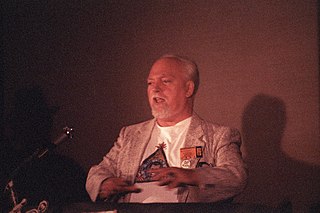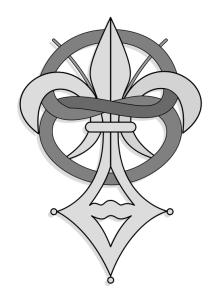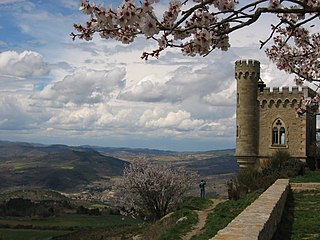
Francis Bacon, 1st Viscount St Alban,1st Baron Verulam, PC was an English philosopher and statesman who served as Attorney General and Lord Chancellor of England under King James I. Bacon argued the importance of natural philosophy, guided by scientific method, and his works remained influential throughout the Scientific Revolution.

Robert Anton Wilson was an American author, futurist, psychologist, and self-described agnostic mystic. Recognized within Discordianism as an Episkopos, pope and saint, Wilson helped publicize Discordianism through his writings and interviews. In 1999 he described his work as an "attempt to break down conditioned associations, to look at the world in a new way, with many models recognized as models or maps, and no one model elevated to the truth". Wilson's goal was "to try to get people into a state of generalized agnosticism, not agnosticism about God alone but agnosticism about everything."

The Illuminatus! Trilogy is a series of three novels by American writers Robert Shea and Robert Anton Wilson, first published in 1975. The trilogy is a satirical, postmodern, science fiction–influenced adventure story; a drug-, sex-, and magic-laden trek through a number of conspiracy theories, both historical and imaginary, related to the authors' version of the Illuminati. The narrative often switches between third- and first-person perspectives in a nonlinear narrative. It is thematically dense, covering topics like counterculture, numerology, and Discordianism.

Rosicrucianism is a spiritual and cultural movement that arose in early modern Europe in the early 17th century after the publication of several texts announcing to the world a new esoteric order. Rosicrucianism is symbolized by the Rose Cross or Rosy Cross. There have been several Rosicrucian organizations since the initial movement was founded, including the Order of the Golden and Rosy Cross (1750s–1790s), the Societas Rosicruciana in Anglia (1865–present), and the Hermetic Order of the Golden Dawn (1887–1903).
The Church of the SubGenius is a parody religion that satirizes better-known belief systems. It teaches a complex philosophy that focuses on J. R. "Bob" Dobbs, purportedly a salesman from the 1950s, who is revered as a prophet by the Church. SubGenius leaders have developed detailed narratives about Dobbs and his relationship to various gods and conspiracies. Their central deity, Jehovah 1, is accompanied by other gods drawn from ancient myth and popular fiction. SubGenius literature describes a grand conspiracy that seeks to brainwash the world and oppress Dobbs's followers. In its narratives, the Church presents a blend of cultural references in an elaborate remix of the sources.

Robert Fludd, also known as Robertus de Fluctibus, was a prominent English Paracelsian physician with both scientific and occult interests. He is remembered as an astrologer, mathematician, cosmologist, Qabalist, and Rosicrucian.

Hermeticism, or Hermetism, is a philosophical and religious tradition rooted in the teachings attributed to Hermes Trismegistus, a syncretic figure combining elements of the Greek god Hermes and the Egyptian god Thoth. This system encompasses a wide range of esoteric knowledge, including aspects of alchemy, astrology, and theurgy, and has significantly influenced various mystical and occult traditions throughout history. The writings attributed to Hermes Trismegistus, often referred to as the Hermetica, were produced over a period spanning many centuries and may be very different in content and scope.

The Rose Cross is a symbol largely associated with the legendary Christian Rosenkreuz, a Christian Kabbalist and alchemist said to have been the founder of the Rosicrucian Order. The Rose Cross is a cross with a rose at its centre, which is usually red, golden, or white. It symbolizes the teachings of a Western esoteric tradition with Christian tenets.

Johannes Valentinus Andreae, a.k.a. Johannes Valentinus Andreä or Johann Valentin Andreae, was a German theologian, who claimed to be the author of an ancient text known as the Chymische Hochzeit Christiani Rosencreutz anno 1459. This became one of the three founding works of Rosicrucianism, which was both a legend and a fashionable cultural phenomenon across Europe in this period.
Pierre Plantard de Saint-Clair was a French technical artist, best known for being the principal fabricator of the Priory of Sion hoax, by which he claimed from the 1960s onwards that he was a male-line Merovingian descendant of Dagobert II and the "Great Monarch" prophesied by Nostradamus. Today in France, he is commonly regarded as a con artist.

Dame Frances Amelia Yates was an English historian of the Renaissance, who wrote books on the history of esotericism.
Philippe Louis Henri Marie de Chérisey, 9th marquess de Chérisey was a French writer, radio humorist, surrealist and supporting actor.
The art of memory is any of a number of loosely associated mnemonic principles and techniques used to organize memory impressions, improve recall, and assist in the combination and 'invention' of ideas. An alternative term is "Ars Memorativa" which is also translated as "art of memory" although its more literal meaning is "Memorative Art". It is also referred to as mnemotechnics. It is an 'art' in the Aristotelian sense, which is to say a method or set of prescriptions that adds order and discipline to the pragmatic, natural activities of human beings. It has existed as a recognized group of principles and techniques since at least as early as the middle of the first millennium BCE, and was usually associated with training in rhetoric or logic, but variants of the art were employed in other contexts, particularly the religious and the magical.

The Da Vinci Code is a 2003 mystery thriller novel by Dan Brown. It is Brown's second novel to include the character Robert Langdon: the first was his 2000 novel Angels & Demons. The Da Vinci Code follows symbologist Langdon and cryptologist Sophie Neveu after a murder in the Louvre Museum in Paris entangles them in a dispute between the Priory of Sion and Opus Dei over the possibility of Jesus and Mary Magdalene having had a child together.
The Jesus bloodline refers to the proposition that a lineal sequence of the historical Jesus has persisted, possibly to the present time. Although absent from the Gospels or historical records, the concept of Jesus having descendants has gained a presence in the public imagination, as seen with Dan Brown's 2003 best-selling novel The Da Vinci Code and its 2006 movie adaptation of the same name that used the premise for its plot. It is dismissed generally by scholars. These claimed Jesus' bloodlines are distinct from the biblical genealogy of Jesus, which concerns the ancestors of Jesus, and from the documented Brothers of Jesus and other kin of Jesus, known as the Desposyni.
A number of writers, some of whom were connected with Theosophy, have claimed that Francis Bacon, the English philosopher, statesman, scientist, jurist and author, was a member of secret societies; a smaller number claim that he would have attained the Ascension and became the Ascended Master Saint Germain.

The Prieuré de Sion, translated as Priory of Sion, was a fraternal organisation founded in France and dissolved in 1956 by Pierre Plantard in his failed attempt to create a prestigious neo-chivalric order. In the 1960s, Plantard began claiming that his self-styled order was the latest front for a secret society founded by crusading knight Godfrey of Bouillon, on Mount Zion in the Kingdom of Jerusalem in 1099, under the guise of the historical monastic order of the Abbey of Our Lady of Mount Zion. As a framework for his grandiose assertion of being both the Great Monarch prophesied by Nostradamus and a Merovingian pretender, Plantard further claimed the Priory of Sion was engaged in a centuries-long benevolent conspiracy to install a secret bloodline of the Merovingian dynasty on the thrones of France and the rest of Europe. To Plantard's surprise, all of his claims were fused with the notion of a Jesus bloodline and popularised by the authors of the 1982 speculative nonfiction book The Holy Blood and the Holy Grail, whose conclusions would later be borrowed by Dan Brown for his 2003 mystery thriller novel The Da Vinci Code.

The Holy Blood and the Holy Grail, published as Holy Blood, Holy Grail in the United States, is a book by Michael Baigent, Richard Leigh, and Henry Lincoln. The book was first published in 1982 by Jonathan Cape in London as an unofficial follow-up to three BBC Two TV documentaries that were part of the Chronicle series. The paperback version was first published in 1983 by Corgi books. A sequel to the book, called The Messianic Legacy, was originally published in 1986. The original work was reissued in an illustrated hardcover version with new material in 2005.

Rennes-le-Château is a commune approximately 5 km south of Couiza, in the Aude department in the Occitanie region in Southern France.

GURPS Illuminati is a supplement for the GURPS tabletop role-playing game about secret societies, conspiracies, and conspiracy theories. Written by Nigel Findley, it was published in 1992, the year before Steve Jackson Games sued the Secret Service, and it won the Origins award for best role-playing game supplement in 1993, as the Origins Awards were not awarded in 1992.